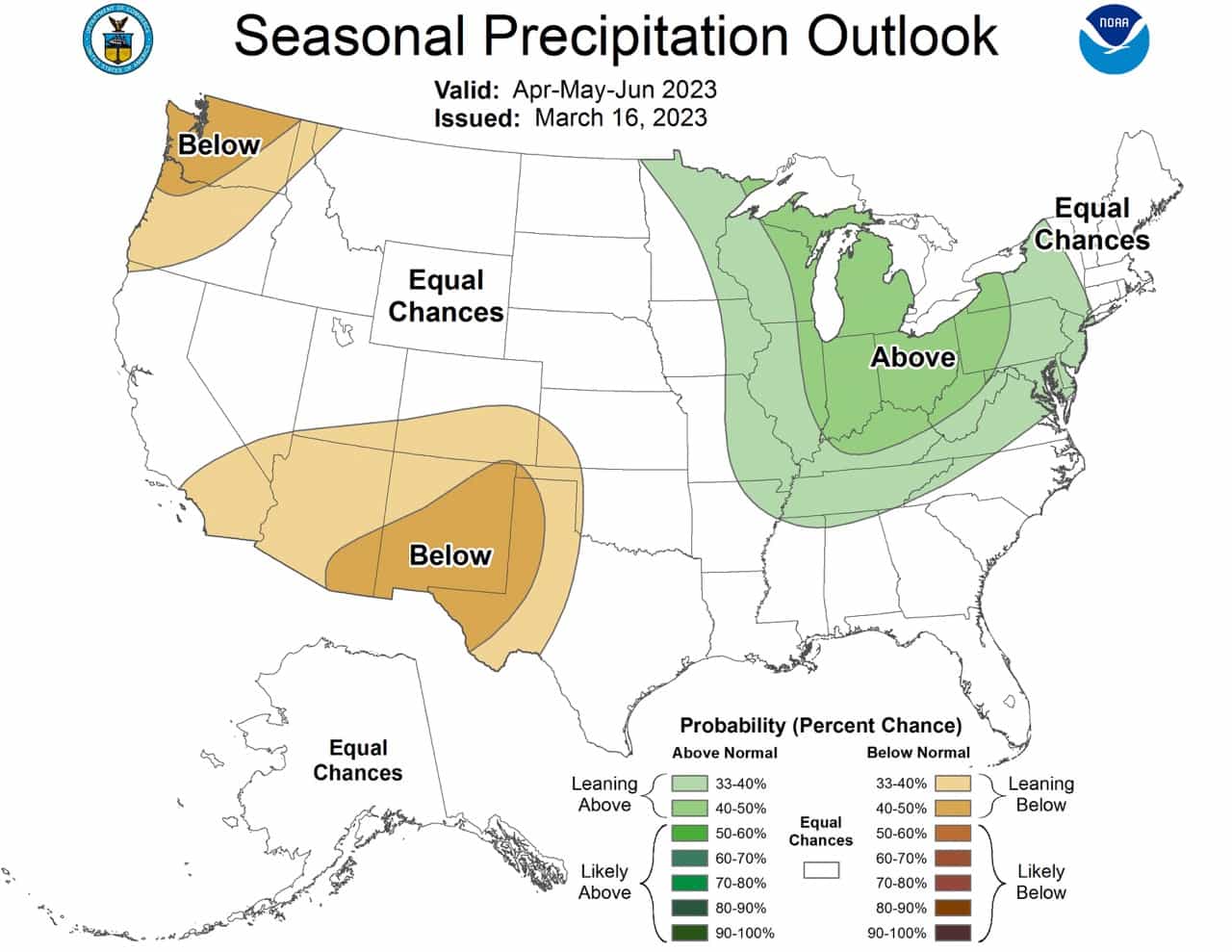
In early March 2023, the final La Niña advisory was issued, and La Niña has ended. ENSO-neutral is now present in the equatorial Pacific Ocean and is favored to continue through the spring and early summer. After that, El Niño is the most likely phase of ENSO from late summer into autumn.
The April-May-June (AMJ) 2023 temperature outlook favors above-normal seasonal mean temperatures for Alaska’s north slope, parts of the Southwest, southern Plains, and Southeast and northward, including the Ohio Valley Mid-Atlantic and Northeast. Below-normal temperatures are likely for portions of the Northern Plains and central interior West.
The AMJ 2023 precipitation outlook favors above-normal seasonal total precipitation amounts for portions of the Great Lakes, Ohio Valley, Mid-Atlantic, and Northeast. Below-normal precipitation is most likely for parts of the far Pacific Northwest and Southwest.
Equal chances (EC) are indicated for areas where seasonal mean temperatures and seasonal total precipitation amounts are favored to be similar to climatological probabilities.

Significant flooding is ongoing in the western U.S., especially in California, following another series of strong Pacific storms that battered the region and piled on to an already historic snowpack. According to NOAA’s U.S. Spring Outlook, the abnormally wet winter will further improve drought across much of the western U.S. as the snowpack melts in the coming months. Winter precipitation, combined with recent storms, wiped out exceptional and extreme drought in California for the first time since 2020 and is expected to improve drought conditions further this spring.
NOAA’s U.S. Spring Outlook highlights temperature, precipitation, drought, and flood predictions for April through June to help the nation prepare for potential weather and climate threats to lives and livelihoods.
“Climate change is driving both wet and dry extremes, as illustrated by NOAA’s observations and data that inform this seasonal outlook. Under the Bipartisan Infrastructure Law and Inflation Reduction Act, and in support of the Biden Administration’s priority to tackle the climate crisis, NOAA will invest significant resources to build a Climate-Ready Nation that gives communities tailored information about changing conditions so that residents and economies are protected.”
– NOAA Administrator Rick Spinrad, Ph.D.

Spring Outlook for drought, temperature, and precipitation
On March 9, NOAA forecasters declared La Nina over. The El Nino-Southern Oscillation (ENSO) is a climate pattern based on changes in rainfall and sea surface temperatures across the equatorial Pacific Ocean that influences temperature and precipitation worldwide. La Nina occurs when ocean temperatures are cooler than normal, and rainfall is reduced in the eastern to central Pacific Ocean.
“La Nina has finally ended after being in place nearly continuously for more than two years. ENSO-neutral — the transition period between El Nino and La Nina — is likely to continue into the early summer with elevated chances of El Nino developing thereafter. ENSO-neutral is factored into NOAA’s Spring Outlook.”
– Jon Gottschalck, chief of the operational prediction branch at NOAA’s Climate Prediction Center, a division of the National Weather Service
The spring wet season is expected to improve drought conditions across the northern and central Plains. Moderate to exceptional drought coverage across the U.S. is at its lowest since August 2020 and is likely to continue improving or end entirely across much of California and the Great Basin. Current drought conditions in Florida are expected to improve or go away during the next three months.
Areas of extreme to exceptional drought across parts of the southern High Plains are likely to persist through spring, with drought also expected to develop into parts of New Mexico. Across parts of the Northwest U.S. and northern Rockies, drought conditions are also expected to continue. Drought may develop in parts of Washington state.
Above-average temperatures are favored for much of the southern and eastern half of the U.S. For April through June, the greatest chance for above-average temperatures exists from the southern High Plains eastward to Florida and northward along the East Coast. Above-average temperatures are also likely for Hawaii and northern parts of Alaska. Below-average temperatures are predicted for the central Great Basin and the northern Plains.

NOAA forecasters predict above-average precipitation this spring across the Great Lakes, Ohio Valley, and into parts of the mid-Atlantic and Northeast. Below-average precipitation is most likely for the Southwest and Pacific Northwest.
Spring flood risk
There is a risk for flooding in most of the eastern half of the continental United States, including most of the Mississippi River Basin. In concert with NWS River Forecast Centers, Forecasters with the National Water Center predict moderate to major flooding along the Mississippi River from Minneapolis, Minnesota, to St. Louis, Missouri.
An above normal to record snowpack in the Sierra Nevada mountains, combined with elevated soil moisture, increases the threat of spring flooding due to snowmelt, especially at high elevations.
“Approximately 44% of the U.S. is at risk for flooding this spring. California’s historic snowpack, coupled with spring rain, is heightening the potential for spring floods.”
– Ed Clark, director of NOAA’s National Water Center
Spring snowmelt will bring welcomed water supply benefits to much of California and the Great Basin. Reservoirs in the Colorado River Basin, such as Lake Powell and Lake Mead, are currently at record-low water levels following years of drought.
Produced by the National Water Center, NOAA’s National Hydrologic Assessment evaluates current conditions of snowpack, drought, soil saturation levels, frost depth, streamflow, and precipitation. Flood risk can change rapidly during the spring season. Stay informed about local flood forecasts and warnings at weather.gov. For more detailed information on flood conditions, visit water.weather.gov.